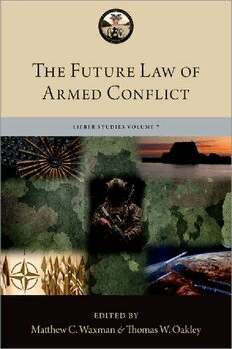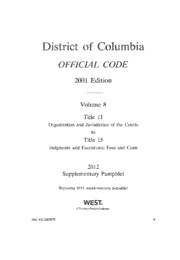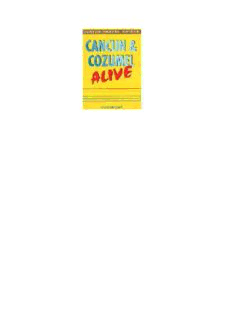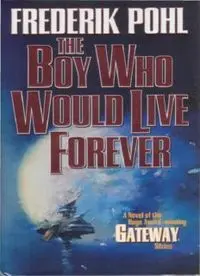
The Future Law of Armed Conflict PDF
Preview The Future Law of Armed Conflict
The Future Law of Armed Conflict THE LIEBER STUDIES Professor and Head, Department of Law, Co- Director of the Lieber Institute for Law and Land Warfare Colonel Winston Williams Professor & Co- Director of the Lieber Institute for Law and Land Warfare Professor Sean Watts Francis Lieber Distinguished Scholar Professor Michael Schmitt Board of Advisors Honorable John Bellinger Lieutenant General (ret.) Dana Chipman Professor Mary DeRosa Sir Christopher Greenwood Dr. Wolff Heintschel von Heinegg Sir Adam Roberts Professor Gary Solis Senior Fellows Professor Laurie Blank Major General (ret.) Blaise Cathcart Professor Robert Chesney Professor Geoff Corn Brigadier General (ret.) Richard Gross Colonel (ret.) Richard Jackson Professor Chris Jenks Professor Eric Talbot Jensen Colonel (ret.) Michael Lacey Professor Rain Liivoja Professor Naz Modirzadeh Daphné Richemond- Barak Professor Beth Van Schaack Professor Matthew Waxman The editors would like to thank the members of the West Point Department of Law for their assistance in making this publication possible. In addition, this pub- lication benefited greatly from the assistance of Natassia Velez. Her tireless efforts during the editing process undoubtedly contributed to the quality of this final product. Finally, a special thanks to Laura Miller, Program Manager of Columbia Law School’s National Security Law Program, for her many contributions to the project, including the cover design for this volume. This is not an official publication of the United States Military Academy, Department of the Army, or Department of Defense. The views expressed in this volume represent the authors’ personal views and do not necessarily reflect those of the Department of Defense, the United States Army, the United States Military Academy, or any other department or agency of the United States government. The analysis presented stems from their academic research of publicly available sources, not from protected operational information. The Lieber Studies is one of the two flagship publications of the Lieber Institute for Law and Land Warfare. It is designed to provide scholars, practitioners, and students with in- depth and critical analysis of the most challenging legal issues re- lated to warfare in the 21st Century. Established by the Department of Law of the United States Military Academy at West Point, the mission of the Lieber Institute is to foster a deeper understanding of the complex and evolving relationship be- tween law and land warfare in order to educate and empower current and future combat leaders. It does so through global academic engagement and advanced in- terdisciplinary research. As such, it lies at the crossroads of scholarship and prac- tice by bringing together scholars, military officers, government legal advisors, and members of civil society from around the world to collaboratively examine the role and application of the law of armed conflict in current and future armed conflicts, as well as that of other regimes of international law in situations threat- ening international peace and security. Lieber Institute for Law and Land Warfare The Lieber Studies V 7 olume The Future Law of Armed Conflict General Editor P M N. s rofessor ichael chMitt Managing Editors B g s r. r rigadier eNeral haNe eeves c W s. W oloNel iNstoN illiaMs d . s r r asha adiN Volume Editors P M c. W rofessor attheW axMaN l c t W. o ieuteNaNt oloNel hoMas akley 1 1 Oxford University Press is a department of the University of Oxford. It furthers the University’s objective of excellence in research, scholarship, and education by publishing worldwide. Oxford is a registered trade mark of Oxford University Press in the UK and certain other countries. Published in the United States of America by Oxford University Press 198 Madison Avenue, New York, NY 10016, United States of America. © Oxford University Press 2022 All rights reserved. No part of this publication may be reproduced, stored in a retrieval system, or transmitted, in any form or by any means, without the prior permission in writing of Oxford University Press, or as expressly permitted by law, by license, or under terms agreed with the appropriate reproduction rights organization. Inquiries concerning reproduction outside the scope of the above should be sent to the Rights Department, Oxford University Press, at the address above. You must not circulate this work in any other form and you must impose this same condition on any acquirer. Library of Congress Cataloging- in- Publication Data Names: Law of Armed Conflict (LOAC) 2040 (Workshop) (2019 : United States Military Academy) | Schmitt, Michael N., contributor. | Lieber Institute for Law and Land Warfare (United States Military Academy), sponsoring body, host institution. | Columbia University. School of law, sponsoring body. Title: The future law of armed conflict / Professor Michael N. Schmitt, Brigadier General Shane R. Reeves, Colonel Winston S. Williams, Dr. Sasha Radin, Professor Matthew C. Waxman, Lieutenant Colonel Thomas W. Oakley. Description: New York, NY : Oxford University Press, [2022] | Series: Lieber studies series ; volume 7 | Includes bibliographical references and index. Identifiers: LCCN 2021056118 (print) | LCCN 2021056119 (ebook) | ISBN 9780197626054 (hardback) | ISBN 9780197626078 (epub) | ISBN 9780197626061 (updf) | ISBN 9780197626085 (online) Subjects: LCSH: War (International law)—Congresses. | LCGFT: Conference papers and proceedings. Classification: LCC KZ6385 .L3835 2019 (print) | LCC KZ6385 (ebook) | DDC 341.6—dc23/eng/20211223 LC record available at https://lccn.loc.gov/2021056118 LC ebook record available at https://lccn.loc.gov/2021056119 DOI: 10.1093/ oso/9780197626054.001.0001 9 8 7 6 5 4 3 2 1 Printed by Integrated Books International, United States of America Note to Readers This publication is designed to provide accurate and authoritative information in regard to the subject matter covered. It is based upon sources believed to be accurate and reliable and is intended to be current as of the time it was written. It is sold with the understanding that the publisher is not engaged in rendering legal, accounting, or other professional services. If legal advice or other expert assistance is required, the services of a competent professional person should be sought. Also, to confirm that the information has not been affected or changed by recent developments, traditional legal research techniques should be used, including checking primary sources where appropriate. (Based on the Declaration of Principles jointly adopted by a Committee of the American Bar Association and a Committee of Publishers and Associations.) You may order this or any other Oxford University Press publication by visiting the Oxford University Press website at www.oup.com. CONTENTS Foreword ix The Honorable John B. Bellinger III Contributors xiii Introduction: The Future Law of Armed Conflict 1 Matthew C. Waxman 1. Future War, Future Law: A Historical Approach 7 Sir Adam Roberts 2. The Jus Ad Bellum Anno 2040: An Essay on Possible Trends and Challenges 25 Terry D. Gill 3. Coding the Law of Armed Conflict: First Steps 41 Ashley Deeks 4. Big Data and the Future Law of Armed Conflict in Cyberspace 61 Paul B. Stephan 5. Being More than You Can Be: Enhancement of Warfighters and the Law of Armed Conflict 83 Rain Liivoja 6. The Law of Cyber Conflict: Quo Vadis 2.0? 103 Michael N. Schmitt 7. The Laws of Neutrality in the Interconnected World: Mapping the Future Scenarios 123 Hitoshi Nasu 8. The Future Law of Naval Warfare: Some Vessel Status Issues 141 Rob McLaughlin 9. The Second Space Age: The Regulation of Military Space Operations and the Role of Private Actors 155 Christopher J. Borgen viii CONTENTS 10. Coalition Warfare and the Future of the Law of Armed Conflict 181 Blaise Cathcart, QC 11. Transatlantic Legal Cooperation and the Future Law of Armed Conflict 199 Steven Hill 12. Who Gets to Make International Humanitarian Law in the Future: A Pluralist Vision 217 Alex Moorehead 13. The Future of Military and Security Privatization: Protecting the Values Underlying the Law of Armed Conflict 239 Laura A. Dickinson 14. A Discursive Analysis of the Chinese Party- State’s Potential Impact on the LOAC 265 E. John Gregory Index 295 FOREWORD The law of armed conflict often looks backward as well as forward. Although all law of war treaties aim to alleviate the prospective suffering of civilians and combatants, States negotiated many of the best- known treaties in response to events in immediately preceding conflicts. The Geneva Conventions of 1949, for example, were negotiated after World War II, building on the Geneva Conventions of 1929, negotiated after World War I.1 Both treaties included provisions to address specific problems relating to the treat- ment of combatants or civilians affected by those two wars. The original Geneva Convention of 1864 was motivated by the suffering of combatants Henry Dunant, that treaty’s champion, had witnessed after the Battle of Solferino.2 Across the Atlantic, the horrors of the American Civil War undoubtedly influenced Francis Lieber to pen General Orders No. 100, known today as the Lieber Code.3 In the latter part of the twentieth century, additional Protocols I and II to the Geneva Conventions were negotiated in response to the colonial wars of national libera- tion and other early Cold War conflicts.4 More recently, the Protocols to the Convention on Certain Conventional Weapons governing Incendiary Weapons and Explosive Remnants of War were negotiated in response to humanitarian concerns in recent regional conflicts, including in Kosovo. And the nonbinding Montreux Document of 2008, which 1. See, e.g., Geneva Convention for the Amelioration of the Condition of the Wounded and Sick in the Armed Forces in the Field, Aug. 12, 1949, 6 U.S.T. 3114, 75 U.N.T.S. 31. 2. See J. Henry Dunant, A Memory of Solferino (1862). 3. General Orders No. 100, Instructions for the Government of Armies of the United States in the Field (Apr. 24, 1863). 4. See Protocol Additional to the Geneva Conventions of August 12, 1949, Relating to the Protection of Victims of International Armed Conflicts (Protocol I) art. 47, June 8, 1977, 1125 U.N.T.S. 3; See also Protocol Additional to the Geneva Conventions of August 12, 1949, Relating to the Protection of Victims of Non-i nternational Armed Conflicts (Protocol II) art. 1, June 8, 1977, 1125 U.N.T.S. 609.
The list of books you might like

Atomic Habits James Clear

The Silent Patient

The 48 Laws of Power

Haunting Adeline

West Knits Book Three

Remèdes de nos grand-mères en 150 recettes maison

Le moment créatif, un outil pour mieux apprendre

World Scientific Handbook of Metamaterials and Plasmonics In 4 Volumes

Research Note - Endoparasites of the Bird-voiced Treefrog, Hyla avivoca (Anura: Hylidae), from Arkansas

On phylogenetic trees - a geometer's view

Pass the PSA

An Integral Guide to Recovery: Twelve Steps and Beyond

A New Species of Cassipourea (Rhizophoraceae) from Western Cameroon

2001 DC Code, Volume 8, 2012 Supplementary Pamphlet, 2001 Edition

Automated Fault Detection in an Upflow Anaerobic Sludge

CALADO, Ana Rita Pinto_Variação da composição nutricional e propriedades de cenouras ...

Greek Government Gazette: Part 2, 2006 no. 633

UFO Mail No 071 2006

Cancun & Cozumel Alive! (Hunter Travel Guides)

The Boy Who Would Live Forever

Legal Status Of Women In Iowa by Jennie L Wilson LL B



